Manx Electric Railway
(formerly the Douglas and Laxey Coast Electric Tramways)
History
The D&LCET commenced electric operations in September 1893 under the auspices of the Douglas Bay Estate Limited. The line was however soon taken over by the Douglas and Laxey Coast Electric Tramway Company Limited (in March 1894), a company which was specifically set up for that purpose, but which was itself quickly renamed — in May 1894 — to the Isle of Man Tramways and Electric Power Co Ltd. The owning company failed in September 1901, and the tramway was taken over from the liquidators by a new entity — the Manx Electric Railway Company — in August 1902, which operated the tramway until its nationalisation by the Manx Government in June 1957. The MER continues to operate tram services to this day.
Uniforms
A couple of good quality photographs have survived from the 1890s, and these clearly show that at this time, staff wore informal attire: namely shirt, jacket, waistcoat and tie. Motormen seem generally to have worn flat caps, whereas conductors wore what were probably company-issued kepi style caps. The earliest photo, possibly taken in D&LCETCo days, shows a tall kepi without a badge, whereas a slightly later photo, probably taken around the turn of the century, clearly shows a kepi topped with a pom pom, and bearing a large oval badge. The latter was an issue of the IofMT&EPCoLtd and was voided (i.e., open backed), comprising the letters: 'IOMT' at the top, 'EPCoLD,' at the bottom and a large '&' in the centre (see below), all in brass; it was probably issued and worn between 1894 and 1901/2.
Photographs of staff taken between 1900 and the 1930s are extremely rare, so it is currently not possible to state with any certainty what uniforms were worn.
By the interwar years, staff were wearing single-breasted jackets with lapels, which appear to have been devoid of insignia, and almost had the look of lounge suits. The sole nod to officialdom was the headwear, which was now military in style with a glossy peak and tensioned crown (top), and which carried a script-lettering grade badge — either Driver or Conductor. It is unclear if these were issued in nickel or brass, or indeed chrome, which many transport concerns switched to during the 1930s and 1940s. At some point, double-breasted jackets were favoured, though whether this was for a defined period only, or whether it perhaps reflected seniority, is unknown.
After the Second World War, apart from some senior platform staff, crews were simply issued with khaki-coloured, single-breasted, dust coats, which were initially worn with the standard military-style caps, but as the years wore on, frequently without. In 1978, smart attire was dispensed with altogether, staff being issued with short blue nylon jackets and cotton caps; by the late 1980s however, a return was made to long, single-breasted dust coats, this time dark blue with an 'Isle of Man Railways' device on the left-hand breast pocket. A few years later saw the reintroduction of a more traditional style of uniform comprising a double-breasted jacket with lapels; likewise, military style caps were brought back, though these no longer carried a grade badge, but an oblong cloth badge embroidered with the system initials: 'M E R'.
It is unclear whether the tramway used inspectors during the early years, as they may have preferred to operate more on railway principles with station masters and or ticket collectors at the main stations. Two good quality photos have survived of station masters — taken prior to 1900 — and these both show that informal but smart attire was worn, along with what was undoubtedly a company-issued soft-topped cap. In one photo, the cap appears to bear two lines of embroidered lettering — possibly the grade — whereas the other appears to show a scroll/ribbon like affair, no doubt containing a grade or the owning company's name.
Other than these early shots, photographs of senior staff are very sparse, and what has survived is from after the Second World War. By this time, senior staff/inspectors were wearing double-breasted jackets with lapels; caps were, like the car crews, military in style and appear to have borne a script-lettering grade badge — presumably Inspector — and possibly metal rather than embroidered.
Although the MER continued to run services throughout both world wars, unlike the vast majority of UK tramway systems, female staff appear never to have been employed.
Further reading
For a full history of the Manx Electric Railway, and its earlier incarnation, The Douglas and Laxey Coast Electric Railway, see: 'Manx Electric' by Mike Goodwyn; Platform 5 Publishing Ltd (1993).
Images
Motormen and conductors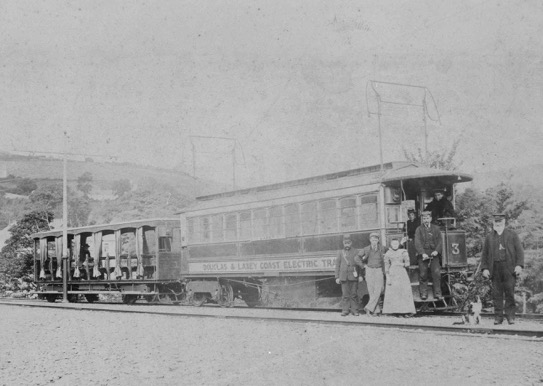
Douglas & Laxey Coast Electric Tramway No 3 stands at Laxey with a toastrack trailer — photo undated, but given that the vehicle is in unmodified condition, but not pristine, probably taken in 1894/1895. Photo courtesy of the National Tramway Museum.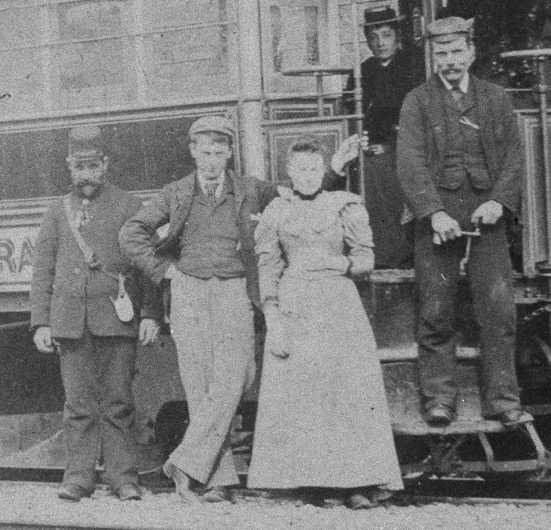
A blow-up of the above photo showing the figures standing around the front platform. The motorman (standing on the steps with the controller handle) appears to be wearing informal attire with a flat cap. The conductor (left) is wearing a single-breasted jacket with upright collars, along with an unusually tall kepi-style cap reminiscent of those worn by post men; neither his jacket nor his cap would appear to bear any insignia.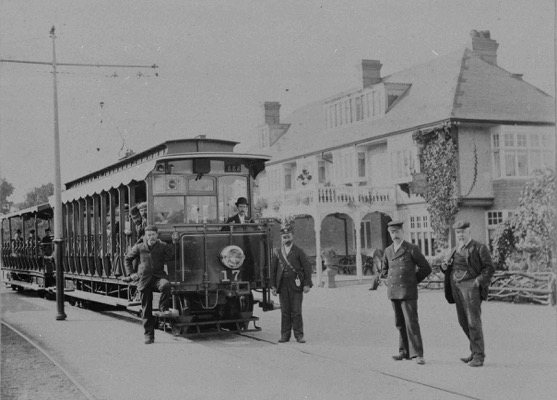
A reasonably new D&LCET No 17 stands with a trailer at Groudle Glen — photo undated, but probably taken around 1899/1900. Photo courtesy of the National Tramway Museum.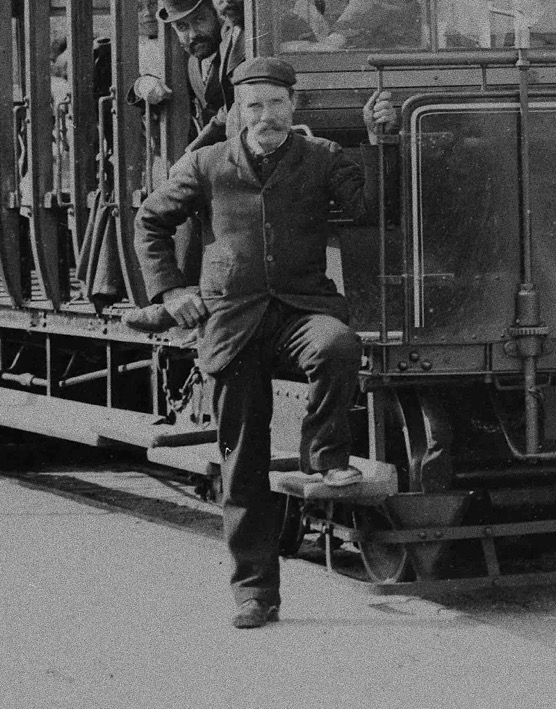
A blow-up of the above photo showing the motorman, who is wearing informal attire along with a flat cap; no badges whatsoever are in evidence.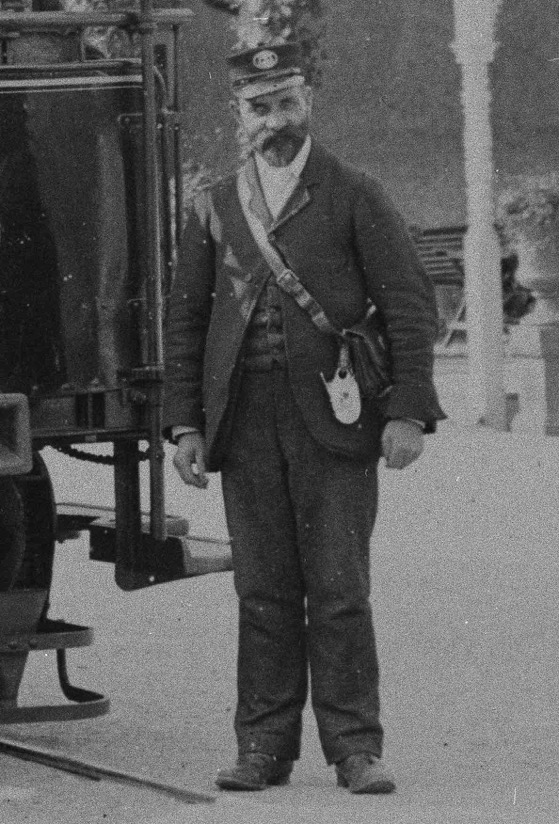
Another blow up of the above photo, this time showing the conductor. Once again his attire would appear to be informal, though smart; his cap however is clearly a company-issued kepi, bearing an oval badge (of unknown pattern) and topped by a pom pom.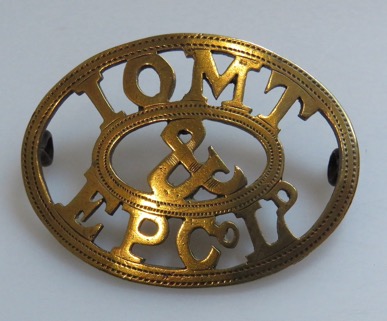
A brass IofMT&EPCo cap badge, worn by conductors between 1894 and 1901/2. Photo courtesy of Manx National Heritage.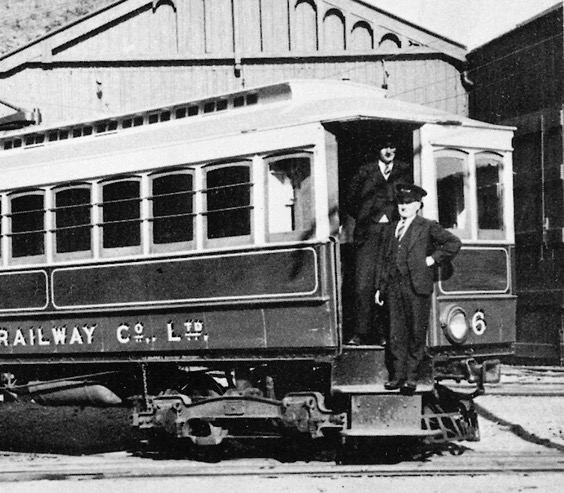
The crew of Tramcar No 6 — photo undated, but possibly taken in the 1930s or 1940s. Both men are wearing single-breasted jackets and waistcoats, seemingly without insignia of any kind; their military-style caps bear script-lettering grade badges. Photo courtesy of the Tramways and Light Railway Society, with thanks to David Voice.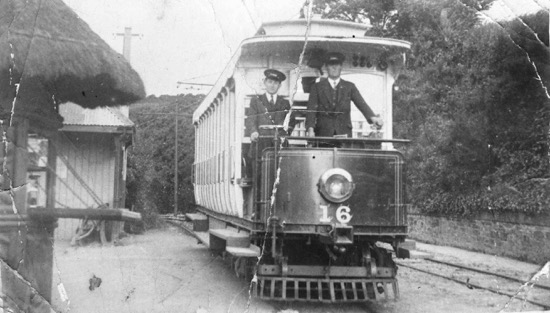
Car No 16 and its crew pose for the photographer at Garwick Glen — photo undated, but almost certainly taken prior to the Second World War. Photo courtesy of the National Tramway Museum.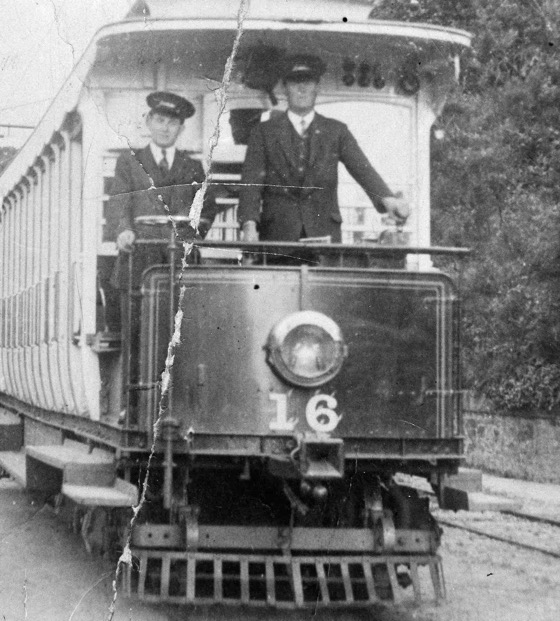
A blow-up of the above photo showing the crew. Although not sharp, it does show that both men are wearing smart but unmarked jackets, along with military-style caps with script-lettering grade badges: Conductor and Driver.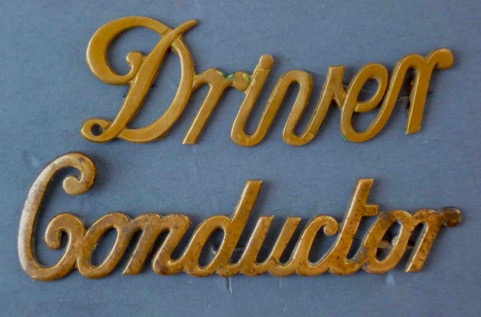
Standard script-lettering grade badges of the pattern used by the MER up until the 1960s, though when they were first issued remains unclear. It is also unclear whether they were issued in brass or nickel, or indeed in later years, in chrome. Author's Collection.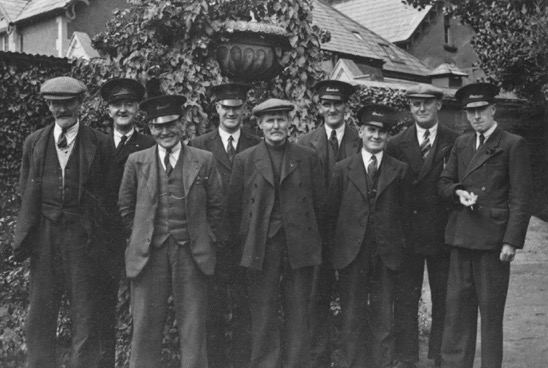
An undated photo, but one which shows MER retired staff. Photo courtesy of the National Tramway Museum.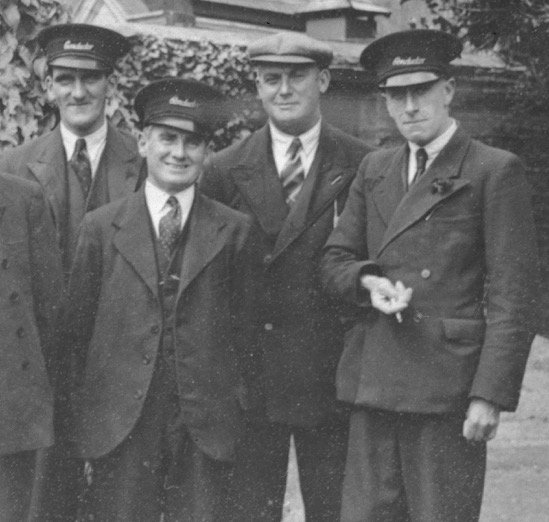
A blow-up of the above photo showing the three of the conductors, all in informal attire, which may not mean anything, but with standard military-style caps with script-lettering grade badges.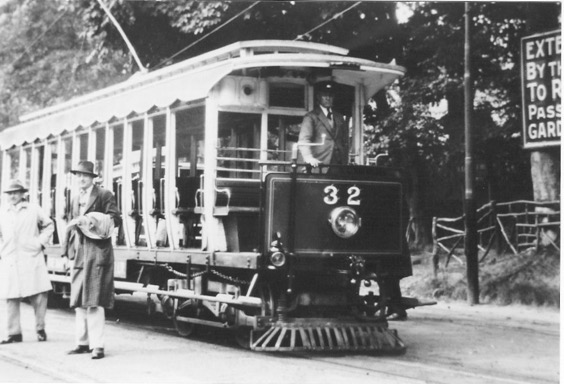
A very smart Car No 32 with motorman at the helm, in a single-breasted jacket and with a military-style cap — photo undated, but probably taken in the 1930s or 1940s. Photo courtesy of the Tramways and Light Railway Society, with thanks to David Voice.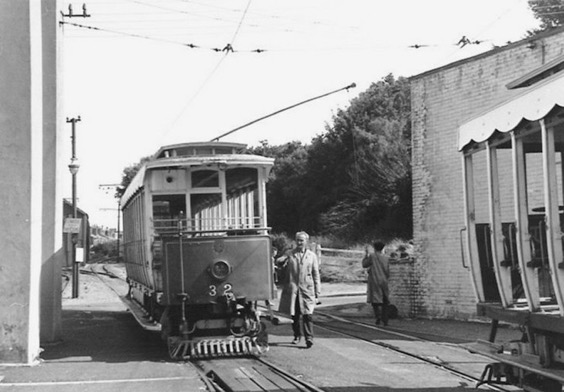
Tramcar No 32 at Ramsey with the conductor, walking away from the camera, turning the trolley pole — photo undated, but possibly taken in the late 1950s or early 1960s when this vehicle was painted in a widely reviled green livery. Both men are wearing long khaki dust coats, which were introduced in the late 1940s; some men however, continued to wear the older uniforms. Photo courtesy of the Tramways and Light Railway Society, with thanks to David Voice.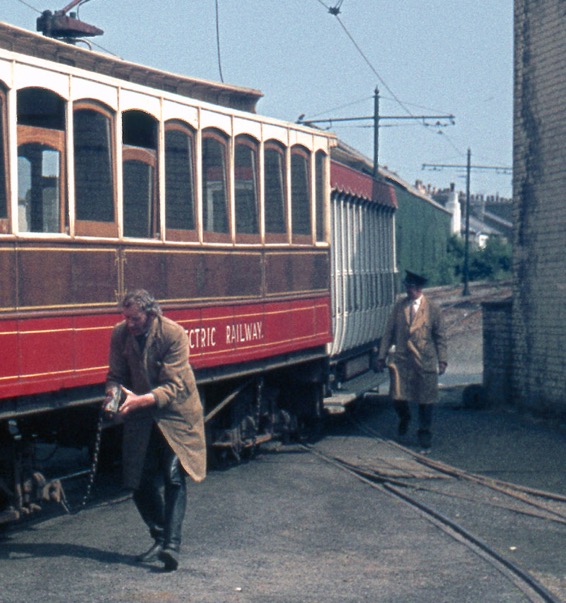
The crew of MER No 21 (and an unidentified trailer) attend to their charges at Ramsey on 29th June 1974. Both men are wearing the usual khaki dust coats, which by this time had been the standard crew attire (with some exceptions) for approaching 30 years. Photo courtesy of the Tramways and Light Railway Society, with thanks to David Voice.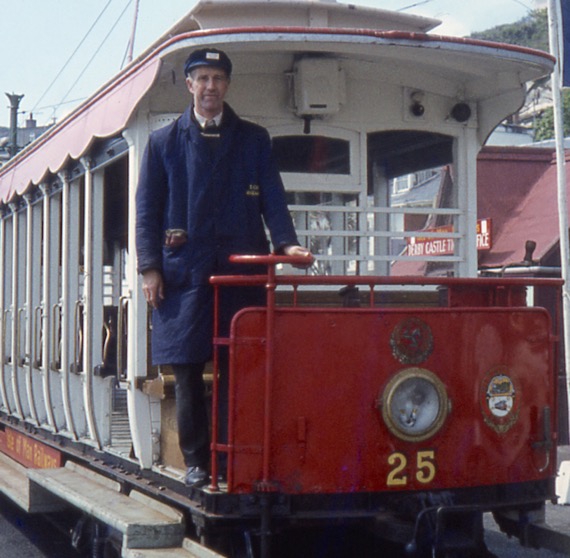
The motorman of cross-bench car No 25 poses for the cameraman outside the Derby Castle ticket office — photo undated, but probably taken in the late 1980s. The subject is wearing a dark blue dust coat and matching cap; the latter bears an oblong badge of unknown pattern, whilst his jacket pocket carries embroidered lettering: 'I O M Railways'. Photo courtesy of the Tramways and Light Railway Society, with thanks to David Voice.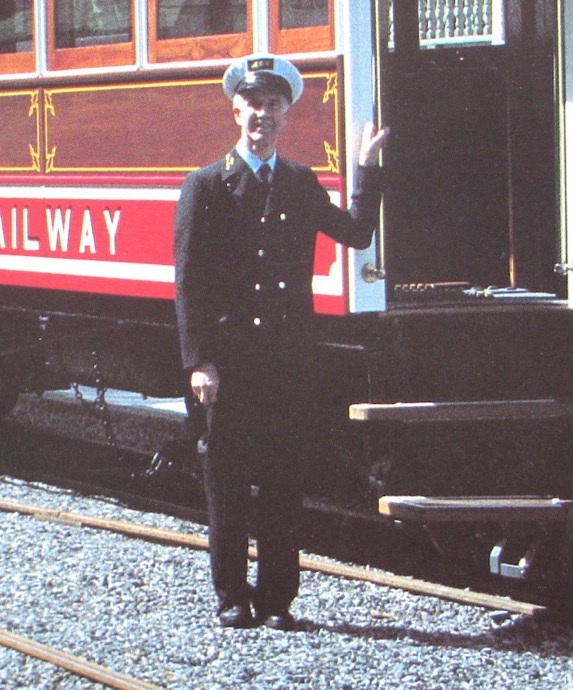
A smartly attired motorman, with controller key, holds onto one of the platform stanchions of a newly outshopped No 22 — photo undated, but given that No 22 was largely destroyed by fire and then totally rebuilt, only being reintroduced to service in 1992, it seems more than likely that it was taken around that year. The uniform reflects a return to more tradition values. The cap bears an oblong cloth badge containing embroidered 'M E R' system initials. Photo courtesy of the Tramways and Light Railway Society, with thanks to David Voice
Senior staff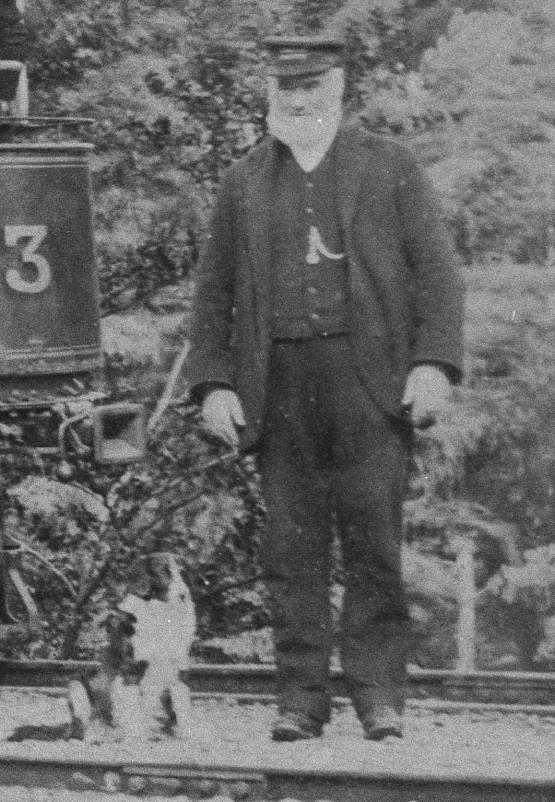
A blow-up of the photo of No 3 above taken around 1895/6. The individual pictured is more than likely the Laxey station master. Although attired in jacket, trousers and waistcoat, they do not look like an official issue (uniform); his soft-topped cap on the other hand bears a two line badge, possibly his grade.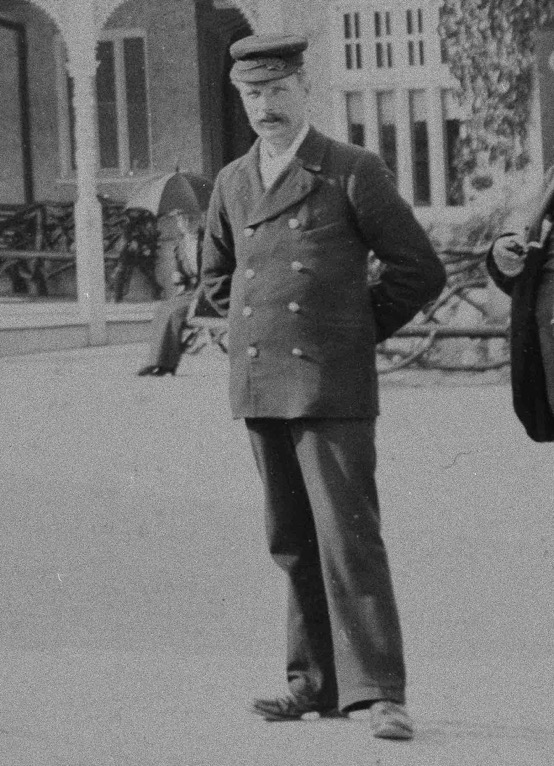
A blow-up of the turn-of-the-century photo of No 17 above showing an individual who is in all probability the Groudle Glen station master. His jacket has the look of a uniform, though once again it is completely devoid of insignia. His soft-topped cap bears some sort of scroll badge, possibly embroidered and bearing his grade.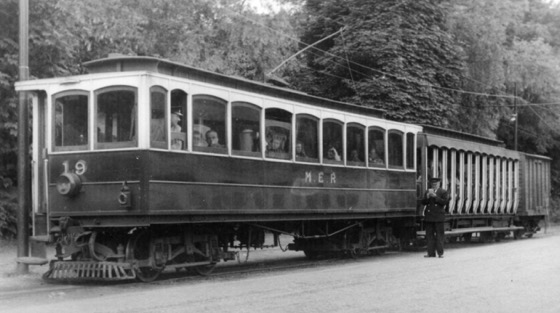
The motorman of Car No 19 looks back at a figure who is in all probability either an inspector or station master — photo thought to have been taken in the 1950s. Photo courtesy of the Tramways and Light Railway Society, with thanks to David Voice.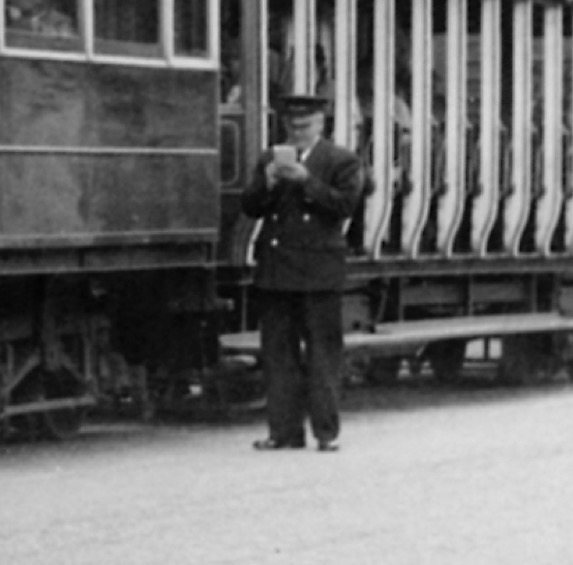
A blow-up of the above photo showing the inspector/station maste; he is wearing a double-breasted jacket, seemingly devoid of badges, and a military-style cap with what is, in all probability, a script lettering grade badge — Inspector — though whether this was metal or embroidered is unknown.